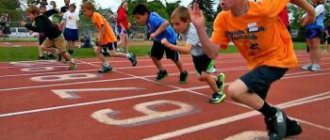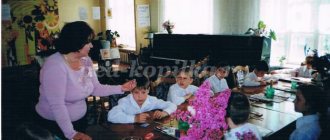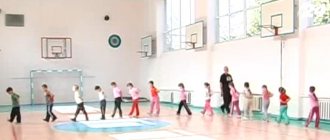Physical education at school is designed to strengthen the health of children and promote the normal physical development of the child. In physical education lessons, students gain important skills in motor activity - running, walking, throwing objects, and so on. Athletics at school develops all these types of physical exercise. This is the main section in the physical training program for schoolchildren.
athletics in elementary school
Athletics is distinguished by its diverse forms of training and variety of exercises. Therefore, children and teenagers enjoy mastering the types of this course. Indeed, the trainer for this sport from Norway, E. Brunem, is right. He said that physical exercise should not only be beneficial, but also joyful. Therefore, goals are achieved through a variety of influences on children from the teacher. We must not forget, no matter what we teach children, first of all, this is the process of educating the individual, the process of forming a healthy lifestyle.
Basics of the educational process
- Formation of the correct worldview of a person, since it is this factor that is decisive in choosing the direction of activity of any person. Physical education aims to form a healthy personality, harmonious development of the child and provide the opportunity to realize his physical abilities.
- Methodological foundations. When building a system of physical education within the framework of a school course, it is necessary to rely on the fundamental principles of the natural sciences - anatomy, biochemistry, physiology, and also take into account the basic principles of pedagogy, psychology, philosophy.
- Regulatory framework. Physical education is carried out in accordance with compulsory school programs developed on the basis of many proven methods. These documents oblige you to adhere to the gradual development of complexes of motor exercises and skills in accordance with the developed programs.
Standards for physical development are formed according to various criteria - age, gender, level of physical development, health, and so on. Training in connection with these standards can be general or specialized.
Physical education at school
General training is aimed at the average student. The School Athletics program involves mastering basic motor skills based on the physical capabilities of the average student in terms of development and health. In the course of general training, the student receives the level of physical condition necessary for normal life and the diversified development of ordinary physical skills.
Sports training involves improvement in one type of physical fitness.
This also applies to athletics at school.
In fact, athletics activities accompany the child from early childhood. Already in kindergarten, during physical education classes, children learn to run, jump, and compete in these exercises. Running, jumping, throwing objects over a distance are present in many children's outdoor games.
Lesson plan on the topic "Athletics" 5th grade
Plan – summary of a lesson in physical education
Topic: Athletics.
5th grade.
Date: 09/08/2015
Place of practice: sports ground
Teacher: Ibragimov Gashim Magomedovich
Equipment: whistle, stopwatch, tape measure, dice, crossbar.
Objectives of the lesson: 1. Consolidate the technique of performing running exercises and distance running.
2. Determination of the initial level of physical fitness of students (speed, coordination and strength abilities, endurance).
| № | CONTENT OF CLASSES | DOSAGE | ORGANIZATIONAL, METHODOLOGICAL INSTRUCTIONS. |
| 1. | Introductory part. (8-10 min.) Construction. Greetings. Reporting the objectives of the lesson, the results of testing in the last lesson (running 30 m; standing long jump; bending for flexibility). Safety instructions for athletics lessons. Varieties of walking and running. Walking in a column one at a time: normal; with different hand positions; accelerated Slow run for 1.5-2 minutes. Walking while performing exercises to restore breathing. General developmental exercise: head turns; head tilt; shoulder lift; shoulder rotation; body turns; bending the torso forward; bending the body to the sides; squat with rotation; jumping with changing leg positions. | 3 min. 5-6 min. | Pay attention to the students' appearance. Possess the skill of monitoring your physical condition through indicators of the development of physical qualities (speed, strength, coordination). Organize health-saving vital activity through warm-up. Calculation and restructuring in three ranks |
| 2. | Main part. (25-28 min.) Consolidating the technique of performing running exercises and distance running. Exercises: 1.Running exercises: -running with a high hip raise in place followed by a 20 m run (repeat 2-3 times) - running with high hip lifts 10-15 m with the transition to running 20 m (repeat 2-3 times - running by jumping from foot to foot 3 x 20 m; -running by jumping 15 m with the transition to running 15-20 m (repeat 2-3 times). 2. Running with acceleration 2 x 40 m. Determination of the initial level of physical fitness of students (speed, coordination and strength abilities, endurance). Control exercises - tests:
| 10 min 15 minutes | Competitive technology. Monitoring the physical development of the student. They evaluate not only the result, but also the process of their achievements. In a person-centered During training, students themselves actively participate in determining the level of physical fitness. – Analyze, determine the causes of errors, etc. Self-knowledge “Know yourself.” Analysis and self-assessment of test exercises by schoolchildren. |
| 3. | Final part (3-5 min.) Exercise to restore breathing and relax muscles while moving (walking) Summing up the lesson. |
Review
on the use of technology of a person-oriented approach when conducting a lesson in athletics in the 5th grade by the physical education teacher of the MKOU "Kundynskaya Secondary School" Ibragimov G.M.
A physical education lesson in grade 5 on the topic “Athletics” was held on September 8, 2015 and was aimed at determining the level of physical fitness of students.
The lesson traced the technology of
a personality-oriented
approach, where the teacher used a form of control over the student’s personal physical development in
competitive
activities. Not only the result was assessed, but also the process of their achievements.
In a student-centered approach to the lesson, the student’s position changes significantly. He does not mindlessly accept the result of control exercises, but actively participates, analyzes, and determines the causes of errors. This helps to develop the individual abilities of students in the lesson.
The lesson created an atmosphere of goodwill, cooperation, interest of each student in the work of the class, and a positive emotional attitude to work throughout the lesson. Gashim Magomedovich also used health-saving
technology throughout the lesson. Conducting a lesson in the fresh air helped saturate the brain with oxygen.
Director of MKOU "Kundynskaya Secondary School" Guidalaev A.G.
Deputy Director for HR: Omarova P.B.
Review
on the use of technology of a person-oriented approach when conducting a lesson in athletics in the 5th grade by the physical education teacher of the MKOU "Kundynskaya Secondary School" Ibragimov G.M.
from 09/08/2015
The teacher’s task is to find an approach to each student that will help him realize himself as an individual, to identify his capabilities that will stimulate his self-development, self-affirmation, self-realization, his physical improvement and, as a result, his desire to be a harmoniously developed personality. This is the essence of
a personality-oriented approach to students in a physical education lesson.
And it is implemented by Ibragimov Gashim Magomedovich through the following methodological techniques: incentives, competitive and individual approach to children.
Health-saving benefits are also taken into account
technologies. The teacher knows which student has limitations and in what type of motor activity and, based on his individual capabilities and medical indications, gives him a certain load regimen with a certain dosage. Conducts an individual conversation with each child. Released students are invited to help organize the lesson. This includes preparing inventory and equipment, monitoring a specific group of students, assisting with assessments, and even assisting in the lesson process. This way of working greatly mobilizes the children and gives them the opportunity to usefully practice the lesson.
Life Safety and Health Teacher at MKOU “Kundynskaya Secondary School” Kunbutaev A.M.
Athletics is the basis of physical education.
In our country, athletics constitute the main part of the school physical education program. And this is no coincidence, since these exercises develop the body most evenly and harmoniously. Athletics exercise systems have a healing effect for the entire body as a whole. In addition to muscle activity, they develop the cardiovascular system, breathing, vestibular apparatus, and reaction. All muscle groups are improved, uniform loads bring pleasure during the lesson.
An athletics lesson at school fosters team spirit and a sense of collectivism. In later life, the skills acquired in athletics lessons will be useful in work life and in army life.
athletics lesson at school
In addition to physical training, the child develops perseverance, willpower, and strengthens character.
The popularity of athletics as a sport is explained by the fact that it is based on natural forms of movement for humans - running, jumping, throwing, walking. This can be done by the most physically unprepared people. These classes do not require special equipment or premises; they are available to everyone. Athletics at school include these exercises.
types of athletics at school
Cross-country athletics
There are several running disciplines: steeplechase, hurdles, relay running, smooth running, cross-country running.
Running with obstacles
In order to take part in an obstacle race, an athlete must have high endurance and agility. During training, the athlete performs physical exercises, learns techniques for overcoming obstacles, and acquires the skills to think tactically.
This type of athletics includes the following areas:
- overcoming obstacles;
- running between obstacles;
- overcoming a hole with water.
Competitions are held both at the stadium and in the arena. The athlete must thoughtfully distribute energy so as not to run out of energy after a couple of obstacles. The method of overcoming the barrier depends on the training characteristics of a particular runner. You don’t have to step on the obstacle, but then you’ll have to spend more effort. Those who step on the barrier lose a little time.
Steeplechase has been an Olympic discipline for men since 1920. They need to run a distance of 2000 or 3000 meters. Women have competed in the sport at the Olympics since 2008. The distance length for them is 2000 meters. The race is held exclusively in summer stadiums. Only low-ranking competitions are held indoors.
Hurdling
In its principles, this discipline is similar to the previous one, which is why they are often confused. The difference between them is that in hurdling the obstacle is not jumped over, but “stepped over”. In this case, the speed is almost not lost. The average length of a hurdle step for men is 3.5 m, for women - 3 m.
The athlete must be able to accelerate quickly on the way to the first barrier. To maintain speed, he needs to maintain concentration and attentiveness. Competitions take place at the stadium and in the arena. The length of the distance for women is 60 and 100 m, for men - 110, 300 and 400 m. Races over 300 and 400 m are held exclusively at the stadium.
Relay race
Relay running is a team discipline. It is mixed in structure, although it has a lot in common with cyclic types of athletics. Athletes take turns walking a certain distance, giving the rest of the participants the right to do the same. The transition from one stage to another is marked by the transfer of the baton or ribbon.
There are several strict rules:
- You cannot run into another participant’s track, otherwise the entire team will be disqualified.
- Until the rest of the team is free, you cannot leave your lane.
- You cannot help another participant. If an athlete drops a stick, then only he has the right to pick it up. In this case, you are allowed to transfer the stick to a comfortable hand while passing the distance. Before passing it to a teammate, you must warn him using your voice.
Classic competitions with a length of 4*100 m or 4*400 m are held at the stadium. The 4*200 and 4*400 distance races are held in the arena. These conditions apply to both men and women. Sometimes competitions are held with unequal lengths of stages and different numbers of stages. For example, two plots of 800 m, one plot of 1000 m and another of 1500 m.
Such relay races are held on the streets of the city. People of different genders and ages can take part in them at the same time. In former times, “Swedish” relay races were popular. The distance was divided into 4 stages. Men were required to run 800+400+200+100 m, women - 400+300+200+100 m.
Cross
Most people know cross-country running as cross-country running. Competitions are held outdoors, in forests or parks. The length of the distance depends on the gender of the competitors. Men need to run 1, 2, 3, 5, 8 or 12 km. The women's distance can be 1, 2, 3, 4 or 6 km.
There are no official standards for the track. The main thing is that it passes through rough terrain and does not have potentially dangerous areas. The cover can be grass or bare soil. The route must be fenced off from the surrounding area using bright tapes. During major competitions, an additional fence is installed, located a meter from the main one. In the resulting corridor there are journalists, photographers, cameramen, event organizers and trainers.
The cross can be further complicated by harsh weather conditions. Precipitation and wind are not a reason to cancel the race. Competitions often take place in the fall and winter.
Endurance running
In endurance running, technique is of utmost importance. You cannot pick up speed too quickly at the beginning of the distance, otherwise severe shortness of breath cannot be avoided. The athlete should lower the foot smoothly, maintaining approximately the same cadence for most of the distance. Incorrect technique leads to early wear of the joints.
The average length of the distances is from 800 to 1500 m. In some competitions you need to cover 1 mile. For running at a distance of up to 3000 m, both an arena and a stadium are suitable. Long distance races (3000, 5000 10000 m) are held only at the stadium.
There are also ultra-long distances that exceed the marathon (42 km 195 m). The longest continuous running distance is 1,300 miles (2,092 km).
Smooth running
Smooth running is running a distance on as smooth a surface as possible. It requires the athlete to have high speed, as well as speed and special endurance. The distance can be short (sprint), medium or long. Athletes train at the stadium and in the arena.
Sprint is a set of disciplines that involve competition over short distances (no more than 400 m). During the Olympic Games, athletes cover distances of 100, 200 and 400 m. These numbers are the same for women and men. The program also includes a relay race at a distance of 4*100 or 4*400 m.
Forms of physical education classes at school
The structure of classes may be different:
- Sections – extracurricular training to prepare for competitions or classes with weak students. Class time is three times longer than an academic lesson, the load is concentrated on one main exercise.
- Independent studies are conducted both within the school walls and outside of it. Individual exercises are practiced or the teacher's homework is completed.
- Trainings are conducted in specialized sections operating from the Youth Sports School to the Educational Institution. The main goal is to prepare for competitions in a specific exercise.
- Competitions are the final form, which involves demonstrating the acquired skills and abilities.
Program requirements for athletics at school
During the years of study in a comprehensive school, a child goes through all stages of formation and maturation. These are the most important and productive years for personality development. At each age stage, a special program of physical development is provided. Load distribution is provided as follows:
Athletics 1st grade – 14 hours
athletics 1st grade
Students in first grade should be able to:
- Run on a flat track at the highest speed for 60 meters,
- Run evenly without stopping for 10 minutes
- In running and jumping, go through a course with 3-5 obstacles
- Jump in height from a running start in a straight line and from the side.
- Throw objects at a target with your right hand
Athletics 2nd grade – 16 hours
athletics 2nd grade
The types of exercises remain the same, the technique of their execution is worked out
Athletics 3rd grade – 12 hours
athletics 3rd grade
In third grade, students develop endurance and exercises become more complex.
Accelerated running, 100 meter run, average 500-1000 meter run.
Throwing (included in the lesson on athletics) is carried out with both hands at a distance, at a target, at a speed of impact.
athletics lesson
The 4th grade athletics lesson summarizes the skills acquired in primary school.
athletics 4th grade
Walking involves simultaneous movement of the arms and requires sufficiently developed coordination of movements when walking over objects or on a narrow bench.
Running involves alternating with walking at a distance of up to 3 km. Schoolchildren must be able to run at an acceleration of 60 m from a low start. To develop endurance and strength, running 100 and 300 meters is used.
The “Athletics 4th grade” program consists of 10 hours of classes.
4th grade athletics lesson
The accuracy of landing in jumps of 50-100 cm is practiced. This exercise is done according to visual references. For example, jumping in drawn circles or hoops placed at a certain distance.
Throwing and throwing objects involves performing the exercise at speed from different positions.
In the outdoor games of the “Athletics 4th grade” program, objects are used that must be hit the target or accurately passed to a partner. These are balls, sticks, hoops.
5-9 grades – 11 o’clock
In grades 10 and 11, the teacher independently regulates the loads and types of sports activities.
Records and record holders in athletics
The history of each sport preserves the names of its heroic athletes, who set records, amazed the imagination and expanded established ideas about human capabilities. And athletics received the title “queen of sports” because there were more outstanding athletes among its “subjects” than in any other sport. Let's get to know some of them.
In the 1930s, the black runner Jesse Owens was called “the greatest athlete of all time.” And this was no exaggeration. Owen was the tenth child in the family of a farm laborer from the American city of Cleveland. Even in junior school, the boy discovered amazing abilities: he was amazingly fast, dexterous and instantly grasped the technique of any, even the most difficult, sports exercise. At the age of 12-13, he was ahead of all his peers in sprint competitions.
At one competition, a 14-year-old athlete ran 220 yards (a little over 200 m) so well that the judge decided that his stopwatch was broken. And at the age of 15 (this was in 1930), Owen covered 100 m in 10.8 s, jumped 1 m 83 cm in height and 7 m in length. When Jesse grew up and became a student, his main goal was to get to the 1936 Olympics. He trained very hard.
And it bore fruit. A year before the Olympics, while competing at student competitions in Michigan, Owen set five world records in sprint and hurdles. His running was magnificent - easy and swift at the same time. But behind this ease were years of hard work.
“Success is not achieved easily and not immediately,” the athlete later recalled. “Just as a sponge absorbs water, an athlete must gain experience and absorb the knowledge of others. Everything serves to achieve one goal...” At the Olympic Games in Berlin, Owens had no equal in all types of programs in which he took part.
Jesse achieved a confident victory in the 100 and 200 m races, then excelled in the long jump, showing a very high result even by modern standards - 8 m 06 cm. And he was awarded the fourth gold medal for participating in the victorious 4X100 m relay race. Clark in Athens he reached a height of 1 m 81 cm, and the American Irving Baxter in Paris conquered the bar at around 1 m 90 cm.
Nurmi won his last Olympic victory in 1928 in Amsterdam at a distance of 10 km. And once again Nurmi's fans greeted him during the Olympics - 20 years later, at the opening ceremony of the Olympics in Helsinki. The great runner was honored to carry a torch along the stadium path and light the Olympic flame.
Features of athletics lessons in primary school
In elementary school classes, students are introduced to the correct ways to walk, run, throw, and jump.
All exercises and skills are practiced in a playful and competitive form, such as relay races and themed games.
It is important to remember that athletics in primary school are game forms of developing basic exercises.
athletics in primary school
- Walking in different ways on heels, toes, lunges, etc. - imitation of animals
- Run sideways, with jumps, with accelerations, with small obstacles, in a circle, in a snake, on a bench.
- Jumping in place, in motion, over obstacles. Learn to do the exercise on one leg or two. Jumping rope.
The teacher is provided with a large selection of outdoor games in which the exercises provided for in the program are practiced. Athletics in elementary school devotes significant lesson time to group games - “Tag”, “Tails”, “Third is the odd one out”, “Hunters and Ducks” and many others.






